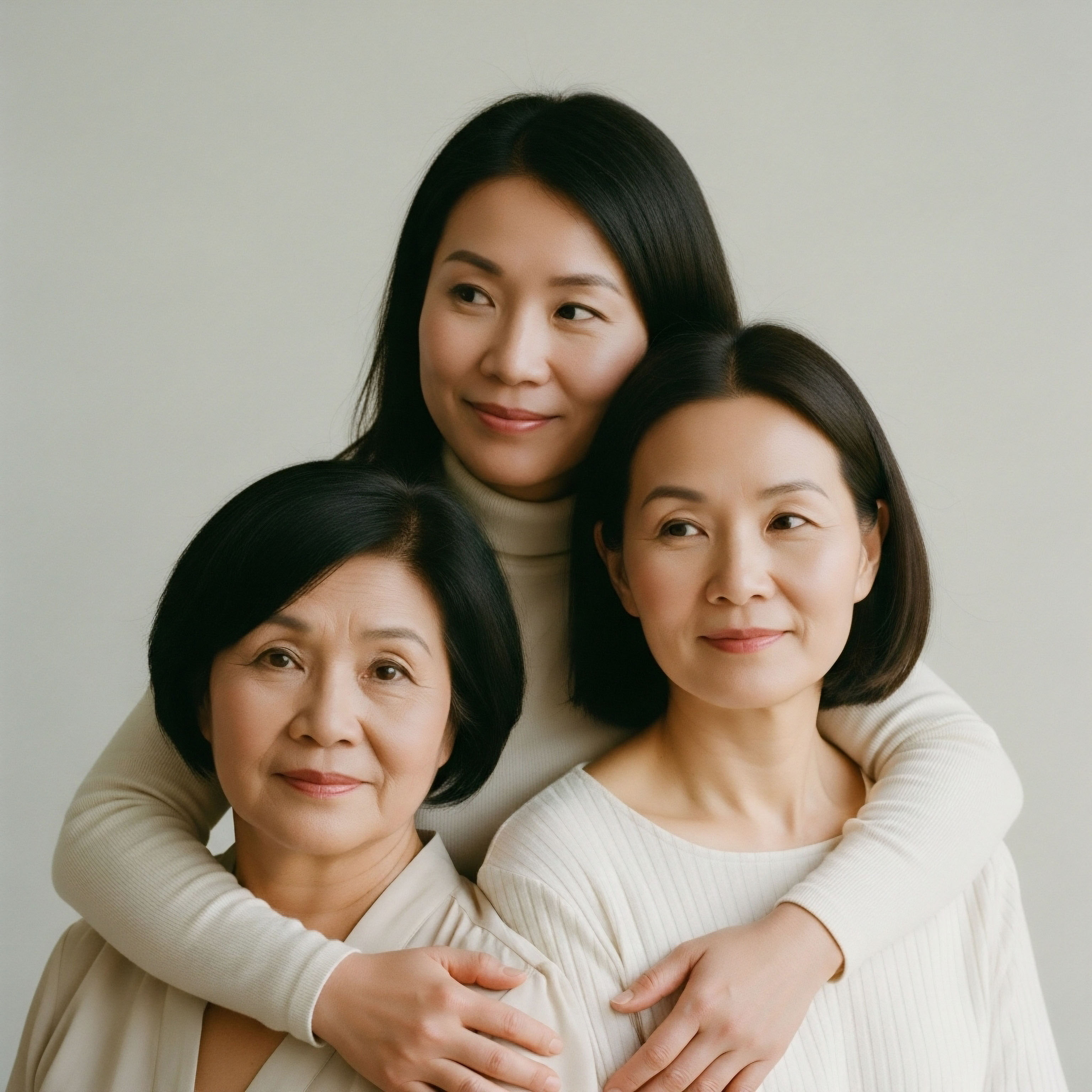

Fundamentals
The feeling can be deeply unsettling. You have been diligently following your prescribed thyroid protocol, yet a familiar fatigue begins to creep back in. Perhaps brain fog clouds your thoughts, or an unshakeable chill persists despite your efforts. When you begin a hormonal optimization protocol, such as estrogen replacement, the expectation is a return to vitality.
Discovering that this new variable seems to complicate your thyroid stability can be disheartening. Your experience is a valid and important biological signal. It is your body communicating a complex, yet understandable, interaction between two of its most powerful regulatory systems.
To comprehend this dynamic, we must first appreciate the distinct roles these hormones play. The thyroid gland produces hormones, primarily thyroxine (T4) and triiodothyronine (T3), that function as the master regulators of your body’s metabolic rate. They dictate how efficiently your cells convert fuel into energy, influencing everything from body temperature and heart rate to cognitive function and digestion.
Estrogen, on the other hand, is a primary female sex hormone that governs reproductive cycles while also exerting profound influence over bone density, mood, and cardiovascular health. These two hormonal systems are deeply interconnected, communicating through a series of sophisticated biochemical signals.

The Concept of Hormone Transport
Hormones do not simply float freely in the bloodstream in unlimited quantities. Many are bound to specific carrier proteins, which act like a dedicated chauffeur service, transporting them safely through the circulatory system to their target tissues. For thyroid hormones, the most important of these transport proteins is thyroxine-binding globulin (TBG).
When a thyroid hormone molecule is bound to TBG, it is inactive and essentially in transit. Only the “free” portion, the unbound T4 or T3, can enter cells and exert its metabolic effects. Your body maintains a delicate equilibrium between bound and free hormone levels.
The method of estrogen administration directly influences the liver’s production of transport proteins, which can alter the availability of active thyroid hormone.

How Estrogen Influences the System
Estrogen has a significant effect on the liver, the organ responsible for synthesizing most of the body’s binding globulins, including TBG. When estrogen levels rise, the liver is stimulated to produce more TBG. This increase in the number of available “chauffeurs” means that more thyroid hormone gets bound up, reducing the pool of free, active T4.
For a person with a healthy, responsive thyroid gland, this change is often compensated for automatically. The pituitary gland senses the slight dip in free T4 and releases more Thyroid-Stimulating Hormone (TSH), prompting the thyroid to produce more hormone and restore balance.
A person with a compromised thyroid condition, such as Hashimoto’s thyroiditis or someone reliant on a fixed dose of levothyroxine after a thyroidectomy, lacks this adaptive capacity. Their thyroid cannot simply produce more hormone on demand.
Consequently, the rise in TBG initiated by estrogen can lead to a functional decrease in available thyroid hormone, causing the return of hypothyroid symptoms even when blood tests for total thyroid hormone might appear normal. The delivery method of the estrogen becomes the critical factor in this entire process.


Intermediate
Understanding the foundational interplay between estrogen and thyroid-binding globulin allows us to examine the specific clinical implications of different estrogen replacement methods. The route by which estrogen enters the body determines its initial concentration and its impact on liver function. This distinction is the primary reason why two women, both on “estrogen therapy,” can have vastly different experiences regarding their thyroid health. The two main pathways, oral and transdermal, create fundamentally different physiological environments.

The First-Pass Effect of Oral Estrogen
When estrogen is taken orally in pill form, it is absorbed from the digestive tract and travels directly to the liver via the portal vein before entering systemic circulation. This is known as the hepatic first-pass effect.
The liver is exposed to a concentrated surge of estrogen, which potently stimulates the synthesis of various proteins, including a significant increase in thyroxine-binding globulin (TBG). This elevation in TBG levels directly increases the blood’s capacity to bind thyroid hormone.
For a woman on a stable dose of levothyroxine, this means a larger portion of her medication becomes bound and inactive, effectively reducing the free T4 available to her tissues. The result is often an increased TSH level and a re-emergence of hypothyroid symptoms, necessitating an upward adjustment of her levothyroxine dose to compensate.

Bypassing the Liver with Transdermal Methods
Transdermal estrogen, delivered via patches, gels, or creams, offers a distinct advantage in this context. When estrogen is absorbed through the skin, it enters the bloodstream directly and circulates throughout the body before it passes through the liver. This route avoids the concentrated hepatic first-pass effect.
Because the liver is not exposed to a high initial dose of estrogen, the stimulus to produce excess TBG is significantly minimized or absent altogether. Consequently, the balance between bound and free thyroid hormone remains largely undisturbed. A woman with a thyroid condition using transdermal estrogen is far less likely to require an adjustment to her thyroid medication dosage, allowing for greater stability and predictability in her overall hormonal health protocol.
Transdermal estrogen delivery avoids the hepatic first-pass effect, thereby preventing the significant increase in thyroxine-binding globulin associated with oral methods.

Comparing Estrogen Delivery Methods on Thyroid Parameters
The clinical differences between these two methods are not subtle. They are measurable and predictable, making the choice of delivery system a critical component of a personalized wellness protocol for any individual with a pre-existing thyroid condition.
| Parameter | Oral Estrogen Administration | Transdermal Estrogen Administration |
|---|---|---|
| Hepatic First-Pass Effect |
High. Estrogen is processed by the liver before systemic circulation. |
Minimal. Estrogen enters systemic circulation directly, bypassing the initial liver pass. |
| Thyroxine-Binding Globulin (TBG) |
Significantly increased due to hepatic stimulation. |
No significant change. |
| Free Thyroxine (Free T4) |
Decreased, as more hormone becomes bound to the excess TBG. |
Remains stable, as TBG levels are not significantly altered. |
| Thyroid-Stimulating Hormone (TSH) |
Tends to increase in hypothyroid patients, signaling a need for more thyroid hormone. |
Generally remains stable, reflecting consistent thyroid hormone availability. |
| Levothyroxine Dose Adjustment |
Frequently required to be increased to compensate for reduced free T4. |
Rarely required. Offers greater stability for thyroid management. |

What Are the Implications for Different Thyroid Conditions?
The impact of estrogen therapy is not uniform and depends on the underlying state of the thyroid.
- Overt Hypothyroidism ∞ Individuals in this group, particularly those post-thyroidectomy or with advanced Hashimoto’s, are entirely dependent on their external supply of levothyroxine. They are the most sensitive to the TBG-increasing effects of oral estrogen and will almost certainly require dose adjustments to maintain a euthyroid state.
- Subclinical Hypothyroidism ∞ These individuals have an elevated TSH but normal free T4 levels, indicating their thyroid system is already under strain. Introducing oral estrogen can be the stressor that pushes them from a subclinical to an overt hypothyroid state by further reducing their available free T4.
- Euthyroid (Normal Function) ∞ A person with a healthy, robust thyroid can typically compensate for the effects of oral estrogen by increasing endogenous hormone production. However, this places an additional demand on the thyroid gland, which may be undesirable long-term, particularly if there is an underlying autoimmune predisposition.


Academic
A sophisticated analysis of the interaction between estrogen replacement and thyroid function requires moving beyond systemic effects and into the realm of molecular biology, pharmacokinetics, and endocrinological feedback mechanisms. The choice between oral and transdermal estrogen administration initiates a cascade of distinct biochemical events, the consequences of which are governed by gene regulation, protein synthesis rates, and the metabolic clearance of hormones. The clinical ramifications are a direct result of these cellular-level processes.

Molecular Mechanism of TBG Regulation by Estrogen
The primary mechanism through which oral estrogen impacts thyroid homeostasis is its influence on the hepatic synthesis of thyroxine-binding globulin. The gene encoding TBG contains estrogen-responsive elements (EREs) in its promoter region. When oral estrogen undergoes its first pass through the liver, high concentrations of estradiol bind to estrogen receptors (ERα and ERβ) within hepatocytes.
This hormone-receptor complex then translocates to the nucleus, where it binds to the EREs on the TBG gene. This binding event acts as a powerful transcription factor, significantly upregulating the rate of TBG gene transcription and subsequent protein synthesis. The result is a marked increase in the serum concentration of TBG. Transdermal administration, by delivering estrogen directly into peripheral circulation, results in substantially lower initial hepatic concentrations, thereby avoiding significant activation of this genomic pathway.

Pharmacokinetic Differences and Clinical Outcomes
The divergent pharmacokinetic profiles of oral versus transdermal estrogen are central to their differential effects. Clinical studies have quantified these outcomes, providing a clear evidence base for therapeutic choices in hypothyroid populations.
The genomic upregulation of the thyroxine-binding globulin gene by high hepatic estrogen concentrations is the core molecular event disrupting thyroid balance in users of oral therapy.
A study published in the New England Journal of Medicine provided definitive evidence of this interaction. In the study, postmenopausal women with primary hypothyroidism on stable levothyroxine therapy were administered oral conjugated equine estrogens.
A significant number of these women experienced an increase in their serum TSH concentrations, with many rising above the therapeutic range, necessitating an average increase in their daily levothyroxine dose of nearly 50%. Conversely, studies examining transdermal estradiol have consistently shown a lack of clinically significant changes in TSH or free T4 levels, obviating the need for dose adjustments.
| Study Focus | Estrogen Method | Key Findings | Clinical Implication |
|---|---|---|---|
| Hypothyroid Women on LT4 |
Oral Conjugated Estrogen |
Significant increase in serum TSH. 47% of participants required an increased levothyroxine (LT4) dose. |
Mandates routine TSH monitoring and probable dose adjustment after initiating oral estrogen. |
| Postmenopausal Women |
Oral vs. Transdermal Estradiol |
Oral estrogen increased TBG by 39.9% and total T4 by 28.4%. Transdermal estrogen produced no significant changes in these parameters. |
Demonstrates transdermal route as biochemically superior for maintaining thyroid stability. |
| Hypothyroid Women on LT4 |
Oral vs. Transdermal Estradiol |
Oral estradiol increased total T4 and TBG, with clinically relevant TSH changes in 30% of participants. Transdermal estradiol caused no major changes in thyroid function. |
Confirms the higher risk of destabilizing thyroid function with oral therapy compared to transdermal. |

How Do Progestins and Other Factors Modify This Interaction?
While estrogen is the principal driver of changes in TBG, the complete picture of hormonal therapy includes progestogens. The type of progestin used can subtly modify the estrogenic effect on the liver. Some synthetic progestins possess androgenic properties that can partially counteract the estrogen-induced rise in TBG.
For instance, medroxyprogesterone acetate may have a slight attenuating effect. In contrast, micronized progesterone, which is structurally identical to the body’s own progesterone, is considered neutral in this regard and does not appear to significantly alter the primary estrogen-driven effects on TBG. Therefore, a protocol combining oral estrogen with micronized progesterone would still be expected to increase levothyroxine requirements in a hypothyroid individual.

Beyond TBG Secondary Effects on Thyroid Metabolism
The interaction extends beyond binding globulins. Estrogen can also influence the activity of deiodinase enzymes, which are responsible for the peripheral conversion of the relatively inactive T4 into the highly active T3. While research in this area is less definitive than the data on TBG, some evidence suggests that estrogen may modulate deiodinase activity in various tissues.
This could potentially alter the T4/T3 ratio, adding another layer of complexity to the hormonal balance. These secondary effects are typically less clinically pronounced than the primary TBG interaction but contribute to the complete systemic picture of how these hormonal pathways are intertwined. For a patient experiencing persistent symptoms despite “normal” TSH and free T4 levels, investigating T3 levels and the T4/T3 conversion ratio may offer additional diagnostic clarity.

References
- Cobin, R. H. et al. “Effects of oral versus transdermal estradiol plus micronized progesterone on thyroid hormones, hepatic proteins, lipids, and quality of life in menopausal women with hypothyroidism ∞ a clinical trial.” Menopause, vol. 28, no. 9, 2021, pp. 1044-1052.
- Chetkowski, R. J. et al. “A randomized, open-label, crossover study comparing the effects of oral versus transdermal estrogen therapy on serum androgens, thyroid hormones, and adrenal hormones in naturally menopausal women.” Climacteric, vol. 8, no. 1, 2005, pp. 38-47.
- Arafah, B. M. “Increased need for thyroxine in women with hypothyroidism during estrogen therapy.” New England Journal of Medicine, vol. 344, no. 23, 2001, pp. 1743-9.
- Mazer, N. A. “Interaction of estrogen therapy and thyroid hormone replacement in postmenopausal women.” Thyroid, vol. 14, suppl. 1, 2004, pp. S27-34.
- Mandel, S. J. et al. “Increased need for thyroxine in women with hypothyroidism during estrogen therapy.” Annals of Internal Medicine, vol. 119, no. 6, 1993, pp. 492-5.
- Jonklaas, J. et al. “Guidelines for the treatment of hypothyroidism ∞ prepared by the American Thyroid Association task force on thyroid hormone replacement.” Thyroid, vol. 24, no. 12, 2014, pp. 1670-751.
- Santin, A. P. & Furlanetto, T. W. “Role of estrogen in thyroid function and growth regulation.” Journal of Thyroid Research, vol. 2011, 2011, Article ID 875125.

Reflection
The information presented here provides a biological and clinical framework for understanding the dialogue between your endocrine systems. It translates the sensations of fatigue or mental fog into a conversation about transport proteins and metabolic pathways. This knowledge is the foundational step.
Your personal health narrative is written in the language of your unique physiology, and becoming fluent in that language is a process of continuous learning and partnership. Consider how these patterns might relate to your own experiences. Viewing your body’s responses as data, rather than as failures, allows you to move forward with clarity and purpose. The path to optimized wellness is one of informed, personalized adjustments, guided by a deep respect for the intricate systems that govern your vitality.



